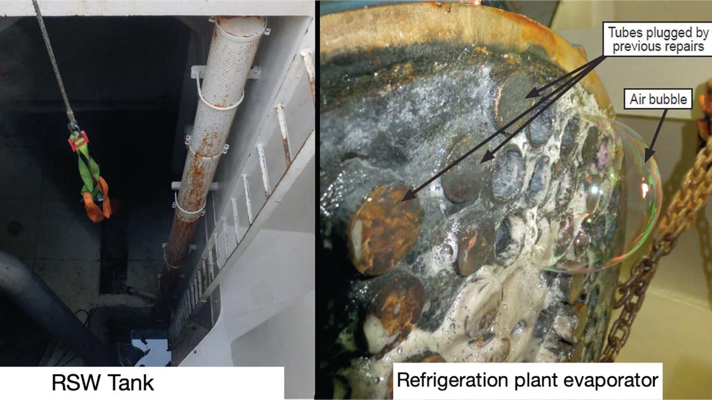A fishing vessel's second engineer lost his life after entering a refrigerated salt water (RSW) tank alone without testing the tank atmosphere. Two of his crewmates were also injured in trying to rescue him.
A medium-sized fishing trawler was in port. Having landed its seasonal quota of herring the crew were preparing for a planned refit period. One item on the refit list was to replace the vessel’s refrigeration plant, which serviced the nine refrigerated salt water (RSW) tanks on board.
The vessel’s refrigeration plant had been shut down. Its RSW tanks had been pumped out and the tank lids opened in preparation for deep cleaning. The vessel’s second engineer entered one of the RSW tanks alone, without advising anyone or testing the tank atmosphere. Sometime later, he was seen lying unconscious at the aft end of the tank by a crewmate, who immediately raised the alarm. Three crew entered the tank and tried to resuscitate the victim but they soon became dizzy, confused and short of breath. One of them managed to climb out of the tank unaided; the other two and the victim were recovered on to the open deck by crew wearing breathing apparatus. The two crewmen made a full recovery, but the second engineer could not be resuscitated and died.
Following the accident, tests of the atmosphere in the tank showed that the level of oxygen at the bottom was less than 6% (normal level =20.9%). Further tests indicated the presence of Freon R22, the refrigerant gas used in the RSW tank’s refrigeration plant.
The official investigation found that the refrigeration plant evaporators had suffered several tube failures necessitating a number of repairs. It is likely that Freon leaked through one or more failed tubes into the seawater system and was released into the RSW tank. Freon R22 is four times heavier than air so it will displace oxygen at the bottom of an enclosed space. It is a toxic, tasteless and mostly odourless gas. If it is deeply inhaled, it can cut off vital oxygen to blood cells and lungs.
Safety Controls
- Widely recognised safety controls for working in enclosed spaces include:
- Atmosphere testing before and during entry.
- Provision of positive ventilation.
- Safety sentry at entry point while persons are in the space.
- Breathing apparatus available for rescue team.
- Safety harness and means of recovering an unconscious person at hand.
Lessons Learned
- All enclosed spaces on a vessel should be identified.
- Entry into any enclosed space should be regulated by a procedure that includes ventilation of the space and testing of the air prior to entry. Additionally, the procedure should include close and continuous supervision by a qualified crew member (safety sentry) at the entrance to the space while it is occupied.
- If an emergency occurs in an enclosed space, entry should only be attempted by crew members wearing breathing apparatus.
Mars Reports
This is one of the March Mars Reports (originally published by The Nautical Institute as Mars 201919 and edited from the UK MAIB Safety Bulletin SB4/2018) that are part of Report Number 317. A selection of this Report has also been published in SWZ|Maritime’s April issue.
Acknowledgement
Through the kind intermediary of The Nautical Institute we gratefully acknowledge sponsorship provided by:
American Bureau of Shipping, AR Brink & Associates, Britannia P&I Club, Cargill, Class NK, DNV, Gard, IHS Fairplay Safety at Sea International, International Institute of Marine Surveying, Lairdside Maritime Centre, London Offshore Consultants, MOL Tankship Management (Europe) Ltd, Noble Denton, North of England P&I Club, Sail Training International, Shipowners Club, The Marine Society and Sea Cadets, The Swedish Club, UK Hydrographic Office, West of England P&I Club
Submit a Mars Report
More reports are needed to keep the scheme interesting and informative. All reports are read only by the Mars coordinator and are treated in the strictest confidence. To submit a report, please use the Mars report form and send it to mars@nautinst.org.








